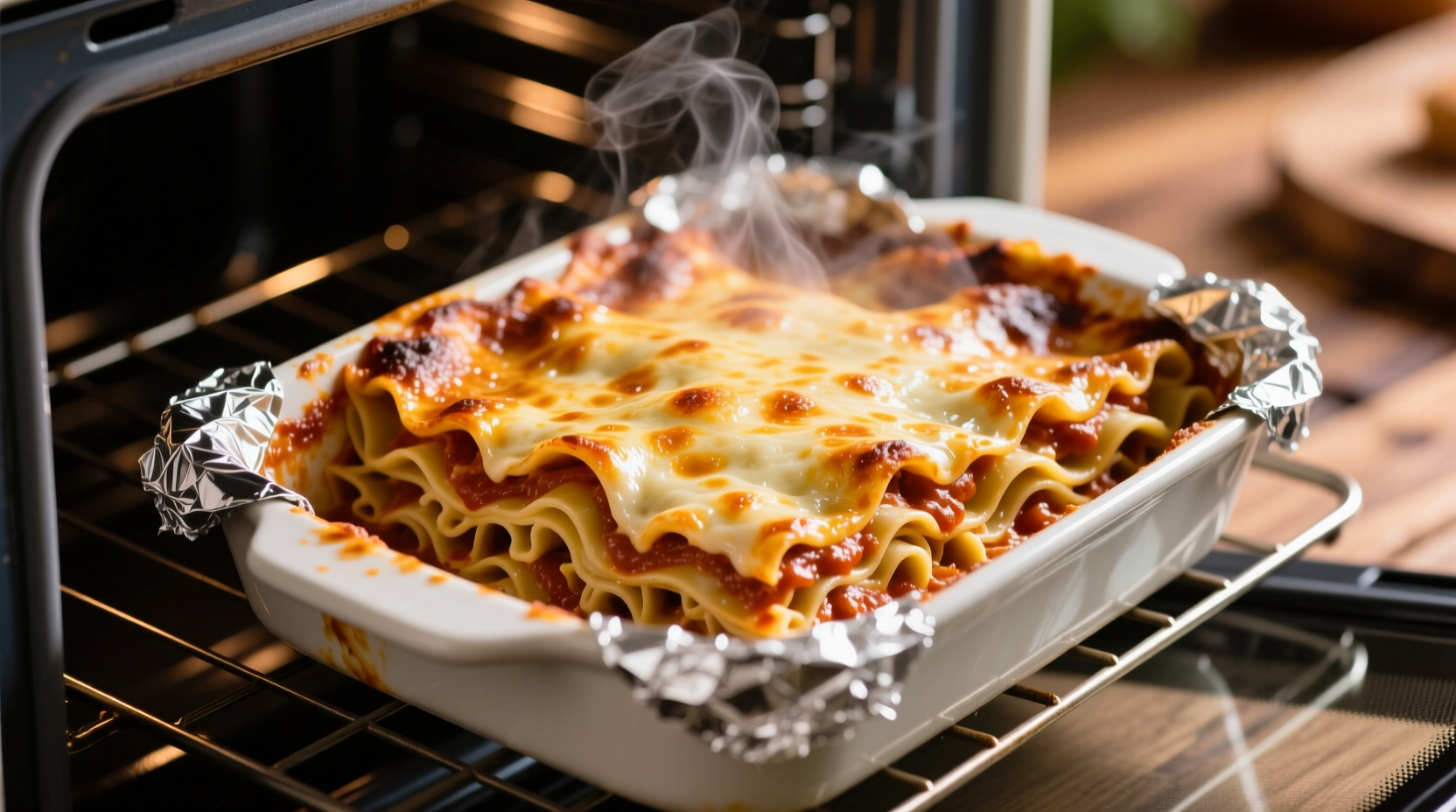Getting lasagna timing right separates soggy disasters from restaurant-quality perfection. Whether you're a first-time cook or refining your technique, understanding the precise variables that affect cooking time ensures consistently delicious results every time you bake this beloved Italian classic.
Why Timing Matters for Perfect Lasagna
Lasagna's layered structure creates unique cooking challenges. Unlike single-layer dishes, heat must penetrate through multiple components—noodles, sauce, cheese, and fillings—each with different moisture content and thermal properties. Undercooked lasagna leaves you with crunchy noodles and cold centers, while overcooked versions become dry and crumbly. The ideal timing balances these elements for cohesive, flavorful results.
Standard Timing Framework
Follow this proven timing structure for traditional lasagna:
| Cooking Stage | Time | Temperature | Key Indicators |
|---|---|---|---|
| Covered baking | 30-45 minutes | 375°F (190°C) | Steam visible around foil edges |
| Uncovered baking | 15-20 minutes | 375°F (190°C) | Golden brown top, bubbling edges |
| Resting period | 15-20 minutes | Room temperature | Steam reduces, layers set |
This two-stage approach solves the fundamental lasagna dilemma: you need high heat to brown the top, but direct exposure too early dries out the delicate cheese layers. Covering the dish initially traps steam to cook noodles thoroughly, then uncovering creates the desirable crust.

Critical Doneness Indicators
Don't rely solely on timers—your senses provide essential feedback:
- Bubbling edges: Sauce should bubble vigorously around the pan's perimeter
- Internal temperature: Insert a thermometer into the center—165°F (74°C) meets USDA food safety standards for cooked dishes containing meat
- Noodle test: Carefully insert a knife into the center; it should slide through noodles with slight resistance (like al dente pasta)
- Steam test: When you remove foil, steam should billow consistently from the surface
Adjusting for Key Variables
Several factors require timing adjustments. These evidence-based modifications come from Culinary Institute of America's research on layered pasta dishes:
Ingredient Variations
- No-boil noodles: Add 10-15 minutes to covered cooking time as they require more liquid absorption
- Meat lasagna: Increase total time by 5-10 minutes to ensure thorough cooking of meat layers
- Frozen components: Add 15-20 minutes to initial covered baking when using frozen spinach or pre-made sauce
Oven Type Considerations
Convection ovens circulate hot air, reducing cooking time by approximately 25%. The American Council for an Energy-Efficient Economy confirms that convection settings typically require:
- Reduce temperature by 25°F (15°C)
- Decrease total time by 15-20%
- Check for doneness 10 minutes early
Troubleshooting Common Timing Issues
Undercooked Lasagna
If your lasagna's center remains cold or noodles stay firm:
- Recover with foil and bake additional 10-15 minutes
- Verify oven temperature with independent thermometer (many ovens run cool)
- Ensure sauce has sufficient liquid—dry mixtures impede heat transfer
Overcooked or Dry Lasagna
Prevent these issues by:
- Using foil correctly during initial phase
- Maintaining proper sauce-to-noodle ratio (3:1 by volume)
- Checking 5 minutes before minimum time
The Science Behind Resting Time
That critical 15-20 minute rest isn't optional. Food science research from American Chemical Society shows this period allows:
- Starches in noodles to fully absorb surrounding moisture
- Fat molecules in cheese to re-solidify slightly
- Temperature equalization throughout the dish
Cutting too soon causes structural collapse—those perfect slices require patience.
Pro Tips for Timing Precision
- Preheat thoroughly: Ensure oven reaches target temperature before inserting lasagna (verify with thermometer)
- Use glass dishes: They conduct heat more evenly than metal, reducing hot spots
- Rotate midway: Counteract oven temperature variations by turning dish 180 degrees during covered phase
- Test early: Check doneness 5 minutes before minimum time to prevent overcooking
How Long to Cook Lasagna in Oven: Complete Reference
Bookmark this comprehensive timing guide for your next lasagna project. Remember that altitude affects cooking times—those above 3,000 feet should add 5-8 minutes to covered baking as water boils at lower temperatures. For best results, combine timer guidance with visual and thermal indicators to achieve that perfect balance of cooked-through noodles and bubbling, golden topping.
How long to cook refrigerated lasagna?
Refrigerated lasagna requires the standard 45-60 minute baking time. No additional time is needed since the dish comes to temperature gradually during baking. Ensure internal temperature reaches 165°F (74°C) for food safety.
Can I cook lasagna at 350°F instead of 375°F?
Yes, but increase total baking time by 10-15 minutes. At 350°F (175°C), bake covered for 40-50 minutes and uncovered for 15-20 minutes. Lower temperatures require longer cooking to properly set the layers and cook noodles thoroughly.
Why is my lasagna watery after baking?
Watery lasagna typically results from insufficient baking time or too much liquid in the sauce. Extend uncovered baking time by 5-10 minutes to evaporate excess moisture. Proper resting time (15-20 minutes) also allows starches to absorb residual liquid for perfect consistency.
How do I know when no-boil lasagna is done?
No-boil lasagna requires 10-15 minutes longer covered baking time. Check by inserting a knife—it should meet slight resistance (like al dente pasta). The top should be golden and edges bubbling vigorously. Internal temperature must reach 165°F (74°C) for food safety.
Should I cover lasagna with foil the entire time?
No—cover for the first 30-45 minutes to trap steam for thorough noodle cooking, then remove foil for the final 15 minutes to develop a golden, crispy top. Leaving foil on the entire time prevents proper browning and can create a steamed texture rather than baked.











 浙公网安备
33010002000092号
浙公网安备
33010002000092号 浙B2-20120091-4
浙B2-20120091-4